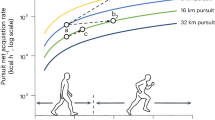Abstract
IT is now generally accepted that the two great albatrosses D. exulans and D. epomophora take about twelve months to rear their young, and if successful breed only in alternate years1–4, but the breeding cycles of the smaller species are not so prolonged and there has been less reason to suppose that annual breeding is not the rule. Recent studies at Bird Island, South Georgia (54° 00′ S., 38° 02′ W.) (ref. 5), however, indicate that although the black-browed albatross D. melanophris breeds annually, the grey-headed albatross D. chrysostoma breeds less frequently.
This is a preview of subscription content, access via your institution
Access options
Subscribe to this journal
Receive 51 print issues and online access
$199.00 per year
only $3.90 per issue
Buy this article
- Purchase on Springer Link
- Instant access to full article PDF
Prices may be subject to local taxes which are calculated during checkout
Similar content being viewed by others
References
Matthews, L. H., Discovery Reports, 1, 570 (1929).
Richdale, L. E., The Post-Egg Period in Albatrosses (Dunedin, New Zealand, 1952).
Tickell, W. L. N., Nature, 185, 116 (1960).
Carrick, R., Keith, K., and Gwynn, A. M., Nature, 188, 112 (1960).
Tickell, W. L. N., Pinder, R., and Clagg, H. B., Polar Record, 12, 601 (1965).
Tickell, W. L. N., Movements of Black-browed and Grey-headed Albatrosses in the South Atlantic (in the press).
Tickell, W. L. N., Biologie Antarctique (Hermann, Paris, 1964).
Morris, R. A., Birds of N.W. South Georgia (unpublished report to officer commanding H.M. Survey Ship Owen, 1961).
Wynne-Edwards, V. C., Proc. Zool. Soc. Lond., A, 109, 127 (1939).
Rice, D. W., and Kenyon, K. W., Auk, 79, 521 (1962).
Rowan, M. K., Ostrich, 22, 139 (1951).
Lack, D., The Natural Regulation of Animal Numbers (Oxford, 1954).
Wynne-Edwards, V. C., Animal Dispersion in Relation to Social Behaviour (Edinburgh and London, 1962).
Ashmole, N. P., Ibis, 103b, 458 (1963).
Author information
Authors and Affiliations
Rights and permissions
About this article
Cite this article
TICKELL, W., PINDER, R. Breeding Frequency in the Albatrosses Diomedea melanophris and D. chrysostoma. Nature 213, 315–316 (1967). https://doi.org/10.1038/213315b0
Issue Date:
DOI: https://doi.org/10.1038/213315b0
Comments
By submitting a comment you agree to abide by our Terms and Community Guidelines. If you find something abusive or that does not comply with our terms or guidelines please flag it as inappropriate.



